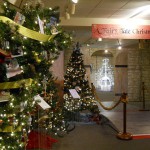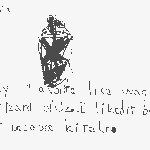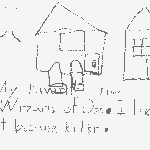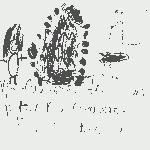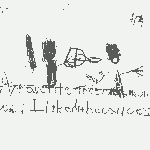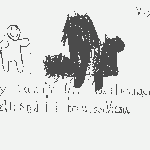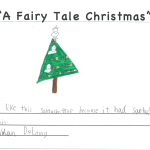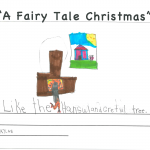Site menu:
|

The Hoover Museum’s newest holiday exhibit A Fairy Tale Christmas features twenty trees decorated to represent different fairy tales. 78 special tours for 1,582 children have been guided by members of the Bethany Lutheran Church. Some of the trees featured this year were: The Gingerbread Boy, The Little Mermaid, Goldilocks and the Three Bears, The Nutcracker, Pinocchio and The Jungle Book. Hope you can join us for a magical time.
And the students at North Cedar Elementary – Lowden and Durant Elementary have sent us this festive commentary!

Dear Staff and Rangers,
Thank you so much for making our visit to the library and grounds a great one. The students enjoyed it and we all learned a lot. This is a trip I will be planning for years to come. You do a great job!
Thanks
Ms. Wenger
6th grade teacher
Moravia

Dear Hoover Site,
Thank you for giving my class a tour around the site. I had a STUPENDOUS time learning about Herbert Hoover’s life. At first I was like “Who is Herbert Hoover?” But now know a lot about ‘Bert. It was amazing learning that Herbert had such a small house. I enjoyed walking through the school and the blacksmith’s shop. I wonder if when Herbert’s father went to work did Herbert miss him. So the main reason that I wrote to you is that I want to thank you for the tour.
Sincerely,
Michaela

That’s Delia Ray, the author of Here Lies Linc, sitting in the middle of 362 enthusiastic TAG students.
A great adventure took place at the Hoover Presidential Library on October 4, when we hosted a Book Talk which included a cemetery sleuth named Julie Zahs, original song lyrics written and performed by Jan Jasiewicz and Mike Phelan, Amazing Grace played on the bagpipes by Bill Sterba, historical tours, boxed lunches in the park, and best of all was hearing Delia’s marvelous presentation as she encouraged us all to be writers.

That’s Delia explaining that the dog on the book’s cover was created from her family’s strange-looking mutt named Griff, who came from the animal shelter and provided the inspiration for C.B. in the book.
Again, thanks to everyone for a wonderful & educational day! It was fabulous!

Dear Herbert Hoover Museum,
Thank you for letting our fourth grade classes visit the Hoover Museum. I learned so much about him. I can’t wait to tell everybody how great it was. My favorite part was the gift shop. You have so many things I loved about the Museum that I can’t even name them all! Thanks so much!
Love
Molly at Westfield

Dear Herbert Hoover Staff,
Thank you for letting us go to the museum. One thing that was something I learned was Herbert Hoover had the same birthday as me. And he liked fishing and I like fishing, too. Something that was interesting was he had two dogs. And he had a very small house when he was little.
Sincerely,
Sydney

Herbert Hoover was born on August 10, or was it August 11, 1874? We’ll never know for sure because nobody glanced at the clock. Was it a few minutes before midnight or a few minutes after? When Bert was old enough his father let him choose the date, and of course a young boy would choose the earlier date over having to wait an extra day!


The following passage comes from MEMORANDA: Being a Statement by an Engineer, Theodore J. Hoover, 1939
Another visiting-place was Uncle Martin Marshall’s. He married my mother’s sister, Ellen. They lived west of the town, about half way to Iowa City. Their house was situated in a narrow belt of natural forest. It is interesting to note that some years later when I read Grimm’s Fairy Tales, this house or the woods around it became to my imagination the scene of most of them. These woods were also for me the scene of “Midsummer Night’s Dream.” Here one could find hickory nuts and walnuts in the autumn, and there was a high swing with hickory poles instead of ropes; there were also several heaps of old disused and long obsolete reaping and threshing machines, which made ideal forts or infernal machines at will; but the finest thing of all was the great pumpkin war. My uncle always raised a large quantity of pumpkins to feed the dairy cows. These would be brought in from the fields and piled in a pyramid, as much as twenty feet high by fifty feet, or more, long. We were allowed to do whatever we liked with all the pumpkins, as long as we cleaned up the debris at the end of the day and placed it in the troughs for the cows when they came home out of the woods at milking time. So we made “Jack-o-lanterns” of every sort our fancy could conceive, and arranged them by companies and battalions and brigades. Then we attacked them, foot and horse, with a corn-cutter, a weapon like a machete or a Circassian sword, and annihilated the whole army. There was no limit to the slaughter save from physical exhaustion with the rather hard chopping. It seems to me I had a companion in those battles, but his face is veiled to me now; it was probably Herbert Clark Hoover.


The following passage comes from MEMORANDA: Being a Statement by an Engineer, Theodore J. Hoover, 1939
Vivid memory begins with the forge in my father’s shop. . . . The shoeing of the large draft horses was an interesting operation, and led to my attributing impossible physical strength to my father because he could hold them by the leg; but of what use is a father, if he be not the bearer of heroic qualities of strength, mind and heart?
For my fourth birthday father made me a wonderful sled, and wisely, to make the gift more appreciated, allowed me to watch the process of its manufacture. He fashioned the runners of steel and devoted much care to the making and ornamentation thereof; the wagon-maker made the top, and it was painted red with green stripes, and my father’s love name for me, “Taddie,” painted across the front in large letters. Though highly appreciated at the time, this sled caused me disappointment a few years later, because of an actual or imagined deficiency in coasting speed, and I put it aside in favour of a proper purchased coaster as soon as I could save up the necessary funds. What would I not give now to have that red sled, the handiwork of my father!


The following passage comes from MEMORANDA: Being a Statement by an Engineer, Theodore J. Hoover, 1939
Another place we were all fond of visiting in the summertime was the Cedar River. It was the nicest plan to take one of my mother’s excellent lunches in baskets, and get some well-beloved family of neighbors or relatives to go the same day. My father was very fond of this diversion, and I have in mind fragmental memories of at least three such excursions. I remember my sister May was present once and on two occasions my brother was there. His memory of one occasion should persist very clearly. We had stopped for lunch in the edge of the natural forest which borders the river on each side for perhaps a mile, and we were all seated around the cloth, which was spread on green grass. My small brother wandered off to conduct researches which were of interest to him; whether he found what he was looking for I know not, but a nest of blue and yellow hornets found him, and they planted a stinger or two in the top of his fuzzy head. He was soon suffering from a complaint which he gets occasionally even now, like everyone else, but on this occasion he was vastly interested in the remedy my father applied, which was a large handful of soft yellow clay; and I remember as if it were yesterday a tear-stained, fuzzy-headed, little boy sleeping peacefully after a period of great emotion, with a large pyramid of mud drying in his hair. This happened within a hundred feet of an old abandoned mine prospect hole, said in those days to have been a silver mine, so that this was the initial grief connected with a mining proposition. Father showed me the silver mine, and held me so that I could look to the bottom, and I satisfied myself by inspection of the fundamental principle that a mine is a hole in the ground; it was some years later that I learned that all holes in the ground are not necessarily mines. So we went onto the river, where Uncle Benijah and Cousin George had preceded us the day before and had caught several of the beautiful, speckled, river catfish of those streams, and of which they had an ample supply for our dinner.
|


